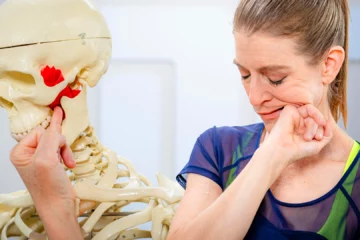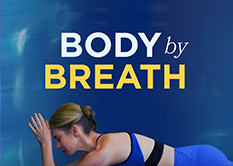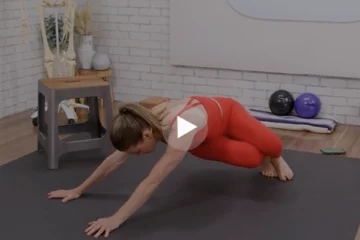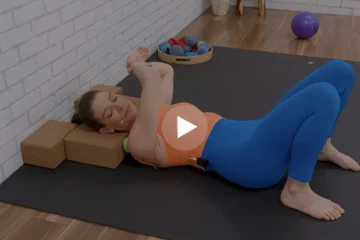
My painful earaches had been unwelcome visitors for years. When I finally scheduled an appointment with my physician, I was symptom free. (Don’t you hate when that happens?) He ruled out infection, fluid buildup, and detected no redness or swelling. Alas, over the ensuing months, the intermittent symptoms continued. I felt so much pressure in my left ear that even the slightest touch on my pillow at night would hurt in an excruciating way. I could barely change sleep positions. Finally, after persistent complaints, my doc referred me to an Otolaryngologist, otherwise known as an ear, nose and throat specialist (ENT).
The ENT palpated my outer ears, he listened to my jaw as I opened and closed my mouth. He asked me questions such as “How much do you chew gum”?
I was surprised to find out that my earaches were symptomatic of TMJ disorder.
Masseter and the Temporomandibular Joint (TMJ)

The TMJ is located in front of each of your ears. It joins the mandible and maxilla, otherwise known as the lower and upper jaws. We use this joint throughout the day (some folks more than others, if they chew too much gum) to chew, talk, yawn, and bite.
The masseter is the thick rectangular muscle in the cheek that functions to close the jaw. It is one of the four muscles of mastication, and considered the most powerful. Clenching and grinding of teeth, particularly under stress, or excessive gum chewing can overwork this muscle. Furthermore, the superficial masseter can refer pain to the face, lower jaw, and even the teeth. With TMJ disorder, the deep masseter refers pain to the ear.
Physical symptoms and ailments can be great opportunities for learning. My education came from the very real lesson of proximity and pain referral. By becoming conscious and informed about the anatomy of the jaw, the source of my earache was identified.
Yoga Tune Up® provides a simple Ball Therapy technique to relieve symptoms of TMJ disorder. If I feel my masseter beginning to spasm as signaled by ear pain, I immediately use my YTU therapy balls to massage out the pain (and you can try it yourself as demonstrated in the clip below!).
Learn about the YTU Therapy Ball Products
Watch the QuickFix Online Videos












Great tips for getting relief in jaw pain. It is quite important that when you are dealing with jaw problems, you know how to deal with the jaw pain. Thank you very much. There are many people out there who will find relief after reading this post and applying these tips and tricks.
Temporomandibular Joint Disorder Foster City
It is amazing how often the referred symptoms of the TMJ are overlooked. I recently spent many months trying to figure out odd symptoms of ear pain and tingling. Saw an ENT who found nothing wrong, dentist couldn’t figure it out, and so on. I have also suffered from neck and shoulder problems, which I discovered were all linked together. It was only my own persistent investigating that I discovered that much of my symptoms were referred pain from my jaw, and also that my jaw symptoms probably were stemming from pelvis and lower body misalignment! The body is fascinating, and it is a shame that more traditional doctors do not always recognize the connections. I had a number of doctors tell me that my ear discomfort and tingling in the face were UN-related symptoms! I am still exploring the amazing connections between my entire body, and want more people to realize that pelvis and jaw problems are often connected! I look forward to continuing my use of the TuneUp balls to explore my body.
I’m super familiar with TMJ discomfort, pain & stiffness- many years ago I detached my mandible in a accident & it’s taken years, several surgeries & lots of patience to be able to speak normally again! Although I don’t usually get earaches with my TMJ situation I definitely have lots of neck & face tension that it contributes to, along with a surprisingly overwhelming amount of scar tissue! But I must admit that Rolling my face specifically my massater really helps my face feel tension free and is super helpful in down regulating for my body.
Hi,
I’ve been suffering with pain and tightness in my right neck, shoulder and jaw. I have an almost constant sensation of pressure in my right ear and there is sensitivity around the back of the ear. It feels like the whole joint is inflamed and there is a thickening of tissue below the temple and behind the ear. I’ve developed an almost chronic habit of self-chiropractic whereby I twist my neck and head to a point of tension and then crack it out. I will try and order the balls and hope you can mail them to me in South Africa. Many thanks!
How amazing is the body, ear pain linking to tight muscles in the jaw- they are so close in proximity, yet seem so far apart. And the awareness you gain in your body – pain in the ear means jaw is tight hence time to roll!
I absolutely love this exercise. I have suffered from night jaw tension for the last five years, and when I first tried this technique I cried out of sheer relief. This technique is an absolute lifesaver. THANK YOU
We never really think about the correlation between TMJ and earaches. What a great article with informative insight. Tight jaw muscles really are a pain!
Great article! I also agree with Sara on how the masseter is often over looked as the expressor of stress. I never realized how tense my masseter was until I tried rolling it out with a YTU ball. I occasionally get ear aches, but I do grind my teeth at night. The dentist recently told me so and couldn’t figure out where it was coming from. The stress from my new job has been manifesting in my jaw… unreal. Thanks for sharing!
Jaw clenching, the often overlooked expresser of stress! I have been hearing the messages of my jaw lately, and am so thankful for the therapy balls!
Wow! I would never think that earaches could be associated with TMJ, but really makes sense reading your article. I have numerous clients with TMJ and/ or are teeth grinders. I am going to recommend the the YTU techniques Thank you!
My tmj is so bad I’m on my second night guard. I’ll try to the ball rolling to see if can help relax the jaw muscles. Thank you.
Wow, this is something I would have never thought of! Is your TMJ due to clenching your teeth? The reason I ask is I have you used the balls to roll out the masseter, however, because I clench all the time without realizing, my muscle memory goes back to where it was maybe an hour later. I’m not sure how to kick the habit and relax that area so that the rolling will stay effective.
My dentist recently told me that I must be clenching/grinding at night, because of the wear only teeth. I hadn’t noticed if I was or not.. Of course, as soon as someone had made me aware, it seems like I was constantly, and most of the time,unconsciously, rubbing the masseter muscles of my face. I’ve been doing my own version of this with the balls for a few weeks now and the bonus has been that my headaches seem to have disappeared! Will try this video tonight before bed!
one thing I know I find myself and my students doing is clenching the jaw, especially when doing a difficult pose or lift. doing an excercise like this draws awareness to this area of the body and the importance of relaxing the jaw muscles and how we use our mouths in daily life.
Mind. Blown. I am so happy to read this article! I have been struggling with TMJ pain for years and I can’t wait to try out the Therapy balls as a remedy! Thanks!!
What great information for those of us who grind, tap, clench, etc. I am definitely in need of this exercise and I am excited to try it. I noticed in the past year that the muscles around the outside of my ears are extremely tight and probably need some attention, too.
I will definitely try this technique. I started to grind my teeth while sleeping when I was in a stressful phase in my life and am not getting rif of it ever since. Even when I am at my happiest, most relaxed, with practicing meditation, relaxation techniques and yoga I might clench my face muscles when sleeping. I almost believe it became a habit of some sort that I cannot stop, since it happens when I have no control over my body movements. Thanks for sharing!
Thank you for talking about TMJ, when the masseter muscle gets tight it can push the padding in the TMJ joint out or it can get stuck which can cause clicking. We use this muscle all the time, so why not give it a massage. If this doesn’t alleviate your problem, in my experience it is caused by something else, such as a head forward position.
This is a winner pose. In addition to TMJ, it helps with the teeth clenching and grinding. The more we do these type exercises and become conscious of relaxing our jaw while we are awake, the greater chances that this relaxation will find itself into our sleep, decreasing the teeth grinding at night and less headaches by day!
Bonnie – Oh my gosh, oh my gosh, oh my gosh!!! This article has connected dots, turn on light bulbs, and convinced me to explore using the therapy ball in a place I never imagined I would want or need to. I was diagnosed with TMJ about 20 years ago when my jaw completely locked up. At the time they gave me lots of chemical medicine to temporarily relieve the symptom. They did the same thing throughout my childhood every time I got an earache, which was several times a year. I never connected the dots of muscles in my face being tight, being in spasm, or locked to earaches that haunted my childhood. I cannot wait to lay down with my ball and start to explore the landscape of my jaw muscles. Jill is so right when she say movement is medicine.
So great! I usually use my hands, but sometimes my fingers get tired from the massage. Yoga Tune Up balls are bound to be more sustainable.:)
Thank you soooo much for this. I feel like there are so many people who know they have tmjd but so few people who know exactly what to do to help them. it seems so essential because it relates so much to how your head feels, where it is in space, and then subsequently trickles down to affect every single inch of your spinal column. having recently broken up with a dentist who is supposed to know more about this than anyone i am happy to report that he doesnt, and you do!
Thanks, Bonnie,
While I have had clicking jaw on one side before, currently I have a grinding sound when I move my jaw laterally. I have never experienced it so graphically before although there is no pain. I have found that external massage and the YTU Therapy balls do not help (although I do use them on the TMJ occasionally. An Osteopath friend said, I need to reach up above the top molars from the inside and massage the muscle here. However, this hasn’t helped. I am thinking I may not be working it enough or it just needs more prolonged and systematic massage.
Any further thoughts before I look for an RMT that might have considerable experience in this area?
Thanks, Bonnie! I’m going to try this out to see if it will help my teeth grinding and also share it with a client who I know has a lot of jaw tension and who seems to suffer from an inordinate number of ear infections every year. Maybe they aren’t infections!
Thank you for reading. Ann, very interesting. I’ll pass on to my students.
I love this YTU ball sequence and your blog. My younger 3 siblings and I are a masseter mess! Whether it is genetic or learned, our lovely father has literally ground his teeth in half, no exageration! We luckily have been aware of this and had bite plates as kids and I gravitated to cranial sacral work which after lots of tears has helped a bunch. I was doing this sequence yesterday and cannot wait to send some balls, your blog, this video over to the kids and my Dad. Lastly, about the gum piece, I have a funny quote from my smarty pants BFF Lexi, “Why would I want to masticate Phenylalanine???” which was her comment to her mother when she gave her gum for a plane ride. If you don’t know Phenylalanine is the amino acid in aspartame which is a highly addictive toxin which is a precursor to tyrosine which can effect production of dopamine, norepinephrine (noradrenaline), and epinephrine. Dangerous mood disorders can come from using this amino and then chewing, yuck! I have found this is a great way educate and get people off gum and on to Peppermint Xylitol Mints by Spry or something simliar. So much safer. Sorry for my rambling, but as you can tell I get pretty heated about this topic.
My yoga teacher always says, Relax your jaw. For good reason. Can’t wait to try these exercises!
Another great use for the YTU balls!
You are both welcome!
Fascinating! Last year I thought I had my first cavity so I went to the dentist to get things checked out. The xrays didn’t show any problem areas, but it was suggested that I might have TMJ disorder. Since then I’ve worn a mouthguard while sleeping, which has provided some relief. I’m hopeful that by practicing the YTU self massage technique of the superficial masseter I’ll be able to stop wearing the mouthguard and eat my sweet treats pain free! Thanks for the post!
I am a Bodyworker and I notice that I often clench my jaw while working. SInce I use my Yoga Tune Up balls on my forearms between clients I’ll now add this one to my between client routine. Thanks!
Thanks Bonnie for the valuable information! I have TMJ and a $300 night guard that I am almost going to have to replace. My dentist has given me exercises to do like neck stretching but never heard of rolling a ballon the face/jaw! Can’t wait to try it when I get home and I’ll be sure to give YTU balls to my mom and sisters with the same problem!
Hi Krista, You’ve been through alot. I’m glad yoga and hopefully the Yoga Tune Up balls have helped!
thank you for this incredibly informative posting. As a severe tooth grinder, my life has been plagued wtih tension, pain, and many, many, broken teeth. It is incredible how much self-damage with can do with an ‘over-active’ masster. (I have thirteen crowns, three implants and nearly a filling in every tooth. I am almost 39- years-old and my dentist has advised me I won’t have much left by the time I’m fifty).
Night guards help but they are expensive and one grinds through them pretty quickly.
I have found that yoga has actually calmed my tooth grinding; Lion’s Breath has been amazing and, after reading this post, I am definitely going to use my Tune Up balls to massage my jaw…this is a great idea. I’ve used the Balls on the other part of my body and you have just turned on the lightbulb!
Thank you!
Hi Amanda! Great to see you :). Thanks for reading!
Thank you, Bonnie! Due to a natural deviation of my jaw, I’ve had jaw pain for as long as I can remember. This YTU Therapy Ball sequence knocks my socks off!!
Thank you Dr. Tanenbaum.
That’s great Chad. It’s been a miracle for me!!
Thank you for posting this. I just tried this technique for the first time after reading your post. I do not experience pain in my jaw, but there is a clicking that I sense pretty often. Right now I do not sense that click. I think something has let go. This will definitely be added to my bag of tricks.
Thank you, Bonnie! I’ll definitely share this exercise with my patients. I’m a TMJ Specialist and recently blogged similarly about the process patients often go before figuring out that their ear pain is actually TMJ. If you’re interested, here’s a link: http://bit.ly/zGsy5q
Also, I recently wrote a book ‘Doctor, Why Does My Face Still Ache?’ which is about getting relief from persistent jaw, ear, tooth, and headache pain. To find out more: http://bit.ly/xOlBLq
Keep up the good work!
Dr. Tanenbaum
Thanks for reading, Dagmar and ika!
[…] Yoga Tune Up® Blog « How I Learned To Listen With My Jaw: The Secret of TMJ Disorder […]
This is interesting – as I have read this about the TMJ disorder and how to relieve it and work with it…to release the stress of the muscle – I now know that I am going to give a bloc and a therapy ball to both my mother and daughter – wonders of knowledge and science as well as engagement and inspiration.
….and as I am a student of my body this is an area to study further.
Vow! Now this connection is absolutely fascinating to me and comes to a massive surprise.It is eye-opening how our bodies work in a ways that is so often beyond any comprehension. That is why the constant curiosity and willingness to study our own structure is of utmost importance for ourselves and the students we want to guide to an increased sense of embodiment.